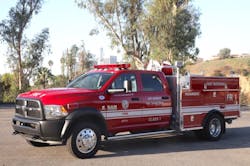LAFD Creates Dedicated EMS Bureau
The importance of EMS to major metropolitan combined departments continues to grow, and the Los Angeles Fire Department has recognized that by elevating its EMS operations into their own bureau, Chief Ralph Terrazas announced in April.
The EMS Bureau’s mission, Terrazas said in explaining the move, is to “ensure the provision of optimal patient care in a timely, efficient and compassionate fashion.” It will be led by the LAFD’s longtime medical director, Marc Eckstein, MD, MPH, FACEP.
“I think it’s a bold decision by the fire chief, and it’s a great privilege to be able to take on this role,” says Eckstein, also a professor of emergency medicine at the University of Southern California’s Keck School of Medicine. “To be able to impact the lives of four million people is a daunting responsibility but an incredible blessing.”
More than 85% of the LAFD’s responses are now medical. Eckstein has served as the department’s medical director for more than 20 years. He will be supported in leading LAFD EMS by Assistant Chief Timothy Ernst and Battalion Chief Corey Rose.
EMS has been handled in different ways by the department over the years but was always integrated with fire suppression. Elevation to its own bureau acknowledges the size and scope of the challenge of providing EMS care, particularly in today’s era of not only a greying population, but an increased focus on value, changing reimbursement, and the emergence of different care mechanisms for complex patients and superutilizers.
“It’s really a paradigm shift for the department,” says Eckstein. “We have to have better systems to help our most vulnerable patients with the right type of response.”
That includes a new Public Health Unit and increased emphasis on the intersection of EMS and public health concepts. Within that unit is a nurse practitioner response unit that rolled out earlier this year, along with added fast-response vehicles and “future specialized field EMS resources.”
Another new endeavor is a planned sobering unit for those with drug and alcohol issues, who are among the department’s most frequent callers. If the unit comes to fruition, those calls could be answered by a paramedic and social worker who, instead of transporting the patient to a hospital, would work with them to get treatment and housing. With city council approval, that could start by September.
What this cumulatively represents is an enhanced embrace of the concepts of mobile integrated healthcare. The best response to some patients, Eckstein notes, doesn’t always involve firefighters on fire engines.
Tiered EMS dispatch will also reside within the bureau, along with training, quality improvement and special operations functions.
“This organization will provide for timely and meaningful EMS training, a robust quality improvement program, continued efficiencies of our dispatch system, and new, innovative methods of providing EMS delivery,” Terrazas said in his announcement. “The consolidation of all department EMS functions under the EMS Bureau will increase our efficiency of delivering the highest quality prehospital care.”
For more, see www.lafd.org.
